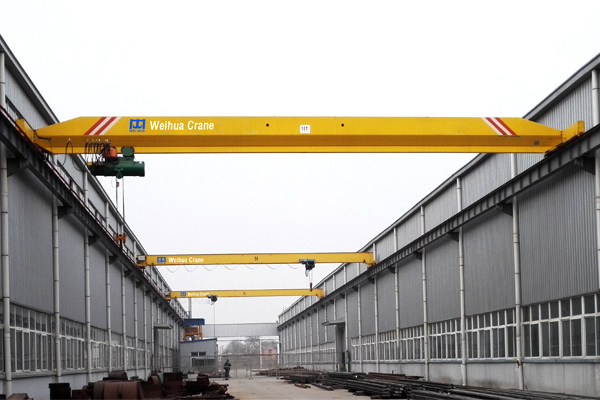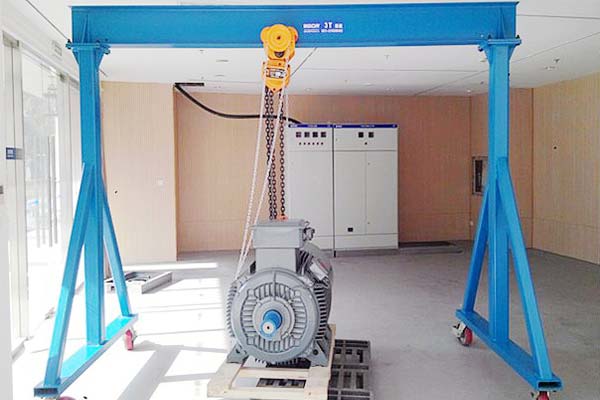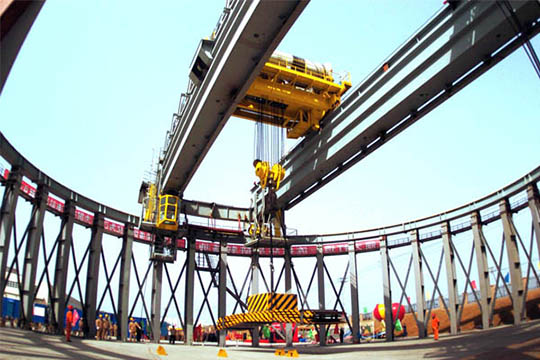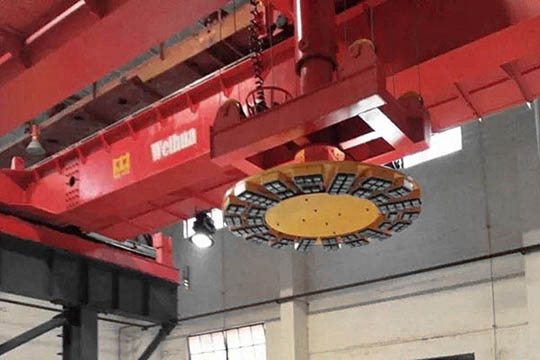How do I choose the right overhead crane?
1 The basic parameters of choice
The basic parameters of the crane characterize the main performance characteristics and operating capacity of the crane is the basis for the correct selection of the crane. The basic parameters of the overhead crane include lifting capacity, lifting height, working level, working speed and span.
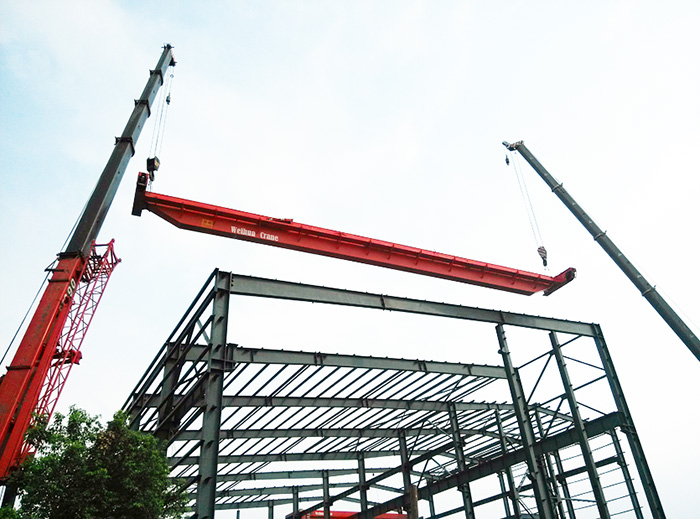
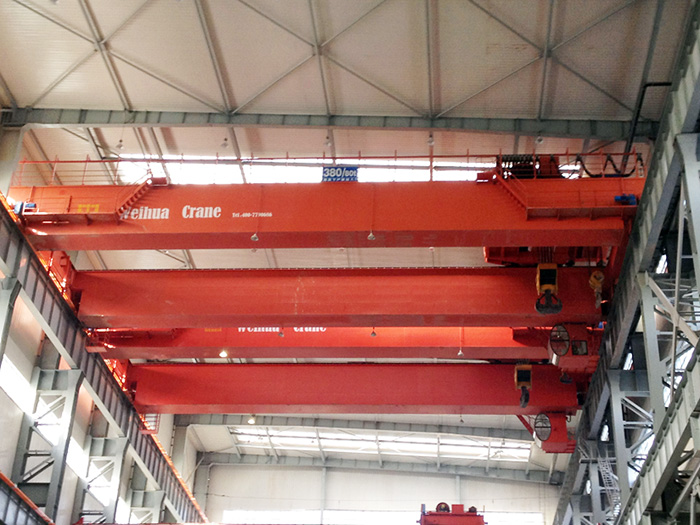
1.1 From the weight
The maximum mass that a crane is allowed to operate during normal operation is called rated lifting capacity. The rated lifting capacity of the crane does not include the weight of the hook and the moving pulley block. Grapple and electromagnetic sucker and other take the device into the rated weight of the weight. According to the standard, the series of lifting capacity of the bridge crane is R10 priority series, starting from 312t, according to 1125 km increments of 4,5,613,8,10,1215,16,20,25,32,40 , 50t ... .... But the current domestic bridge crane products are only based on years of production practices, selected from the above part of the composition of the actual series from the weight. The most commonly used series is 5t, 10t, 16t, 20t, 32t and 50t.
Normally, when the weight is more than 10t, two lifting mechanisms, namely the main hoisting mechanism and the sub-hoisting mechanism, are set to a weight ratio of about 1: 4. The main hoisting mechanism has a large lifting capacity Heavy cargo; sub-hoisting mechanism from the weight of small, but faster, to lift the lighter goods or for auxiliary work to improve work efficiency.
Generally should be the crane may encounter the maximum lifting weight to determine the weight, taking into account the conditions of the work or process requirements. Cranes are not allowed to use overload, so the crane should be considered a certain margin when the lifting material is constantly changing. In some cases, occasional hoisting of overweight objects can be done with two cranes. In the process of fixed, the weight of the lifting material is basically the same, the crane is fully loaded with the case, you can cancel the sub-hoisting mechanism to simplify the crane structure, reduce costs. Foreign large tonnage bridge cranes are not all with a sub-hoisting mechanism, but according to the need for optional.
1.2 Lifting height
Lifting height refers to the vertical distance from the ground to the maximum lifting position of the take-up device. If the take-off device falls below ground, the vertical distance from the ground to the lowest position of the pick-up device is called the depth of discharge. The total lifting height at this time is the sum of the lifting height above the ground and the depth of the floor below the ground.
The lifting height of the selection depends on the job requirements. Generic bridge cranes generally limit the lifting height to less than 20m. Because more than 20m will be in the hoisting mechanism on the use of special wire rope winding or increase the size of the reel, so that the lifting truck layout difficult, and increase the size of the crane size. For cranes with loading requirements, the height of the hoist and the height of the vehicle shall be taken into account in determining the lifting height to ensure that the crane can load the maximum height of the vehicle into the vehicle. For the ship (marine facilities problem analysis) loading and unloading of the crane should consider the impact of tidal fluctuations.
1.3 The work level
The installation of the bridge crane and the use of the conditions vary widely, the use of lifting capacity and operating frequency vary. In order to economically and rationally use the crane, according to the working conditions of the crane to select the appropriate level of work. The working grade of the overhead crane is divided into A1 ~ A8, which can be determined according to the utilization level and load status of the crane, that is, according to the busy and the degree of full load.
The crane has a certain number of total working cycles during the life of the crane. A working cycle for a crane operation is the entire process from the beginning of the preparation of the lifting item to the next lifting item. The total number of work cycles represents the degree of utilization of the crane. For ease of calculation, the total number of work cycles is divided into 10 utilization levels within its possible range.
The load status indicates the severity of the load on the crane. The load condition is related to two factors: one is the ratio of the actual hoist load Qi to the rated load Qmax, and the other is the ratio of the number of times Ni to the total number of cycles N of the actual lifting load Qi. Nominal load spectrum coefficient is divided into four levels, the crane load spectrum coefficient KQ can be calculated m is the index of the material fatigue test curve, here take m = 3.
The closest nominal load spectrum can be found.
After determining the utilization level and load status of the crane, the working level of the crane can be determined.
The working grade of the bridge crane can also be selected.
1.4 Working speed
The working speed of the overhead crane includes the lifting speed, the running speed of the trolley and the speed of the cart. The choice of working speed depends on a variety of factors. First of all, with the weight, medium and small weight of the crane to choose high speed to improve productivity, large weight of the crane should use low speed to reduce the drive power, improve the smoothness and safety of the operation. The working speed also depends on the work level and the use of requirements, high level of work, often used, requiring high productivity of the crane selection of high-speed; low level of work, for the operation of the adjustable operating mechanism can choose low speed; only for equipment installation and maintenance In addition to the crane should use low-speed, but also according to need, using two-speed (fast, slow), micro speed or speed. The use of frequency control can make the working speed between 1:10 arbitrary adjustment. Work speed is also related to the size of the service space of the crane, running a long journey, lifting height should choose high-speed.
When the crane is running a short distance, it is not appropriate to use high-speed, so as not to start after the start brake. But with the development of modern industry, do a lot of heavy work of the crane increasingly use of high speed, installation and maintenance of a large number of cranes with speed. For some special functional cranes, such as cranes for work hardening operations, there should be a rapid descent device; large lifting height of the crane should be appropriately increased in accordance with the lifting speed, but also heavy-duty low-speed, no-load using high-speed, or Take measures to achieve a higher rate of decline to increase productivity.
1.5 Span
The horizontal distance between the centerlines of the bridge crane is the span. The span of the crane depends mainly on the width of the service space, and the span for the crane within the plant depends on the width of the building. In order to serial parameters of the span, bridge crane commonly used span every 3m for a level, see the specific value. Crane with a weight of 50t or less has two span values for each plant span and a small value in the case of a safe passage on the crane beam above the plant. If there are more than 80t cranes on the same track, there are cranes with a capacity of 50t or less, and the span of the crane is selected by a crane of 80t or more. When there are two cranes within the same span, the values in the table are only applicable to the upper cranes, and the span of the lower cranes should be an integer multiple of 015 m. When the span does not meet the values listed in the table are generally special design crane.
2 The choice of structural form
Choosing the right bridge, lifting trolley, maneuvering method and take-up device can make the bridge crane better meet the requirements under various installation and operation modes.
2.1 Bridge
The bridge is the main body of the metal structure. The bridge of the bridge crane has two types of single beam bridge and double beam bridge, which consists of one or two main girders and one end beam on both sides of the span. Under the weight of 10t, the work level is low, the span is small, the running speed is not high, the crane is not frequent use of the case, the general use of single beam bridge.
This single-beam crane is usually powered by electric hoist as a hoisting mechanism, so compact, light weight, the price is relatively low. In other cases can choose double beam bridge, good stability, stress conditions are good, running performance is also better.
In order to meet the requirements of a particular plant building structure, the form of the bridge can take corresponding changes. Under normal circumstances, the main beam and the end of the beam to take a horizontal connection, easy to manufacture, easy to adjust.
Sometimes the plant building structure has been identified, in order to meet the lifting capacity and lifting height requirements, in the case of high trolley, the main beam can be used in the form of concave. Sometimes in order to reduce the height of the plant crane beam, to minimize the weight of the building structure of the plant, the main beam and the end beam can be equal to the high connection.
2.2 Lifting car
Lifting trolleys are used to achieve lifting and lifting along the bridge, its performance directly affects the performance of the entire crane. Double beam bridge crane is generally used on the type of lifting car, carrying capacity, smooth operation, but the size of large. This lifting car is generally arranged in the motor, reducer, reel composed of hoisting mechanism. In order to reduce the height of the building, reduce the weight, simplify the structure, you can use electric hoist as a hoisting mechanism. Electric hoist bridge crane machine weight than the former light about 30, more suitable for plant buildings on the height and the wheel pressure has limited the situation, has a large number of foreign use.
Single girder cranes are usually powered by electric hoists as lifting and trolley, and are suspended in the lower part of the single girder. This structure is lighter, lighter weight. But the gourd will affect the rise under the height.
Sometimes in the plant building height is low, but also as much as possible to increase the height of the case, the choice of low construction height electric hoist single girder crane. This crane to the electric hoist placed in the side of the single beam, to increase the lifting height of the purpose. This kind of crane must take special measures, the hanging electric hoist need to increase the counterweight to maintain balance, but also increased the weight; the other using the car side hanging, but also effective use of space, but the car structure is complex, but also to The main beam is attached with a torque.
2.3 Manipulation
For heavy, high level of work, fast running cranes, the general use of the driver room to ensure safe operation.
The cab is usually fixed on one side of the bridge. If the crane span is large, in the case of complex operation, you can use the driver room with the lifting car with the form of movement. Sometimes you can also choose the driver room to move along the main beam in the form of free, more convenient operation.
In the crane running low speed, short trip, the work is not busy, and asked the driver to hang directly, pick the hook; in the plant low or high ground equipment, can not install the driver's room; in the upper part of the plant there are harmful gases, In the case of manipulation, ground manipulation can be used. Ground operating crane running speed is generally not more than 45m / min. Ground control with hand-held door fixed, hand-driven door with the car to move, flashlight door to move several ways, according to the need to choose. As a result of the use of ground control cable connected, the operator must follow the crane movement, it can also use wireless remote control mode, including infrared light or radio remote control, so that the crane more flexible and convenient operation.
This mode of operation has been widely adopted abroad.
2.4 Take the device
Choose the appropriate take-up device, for safe production and improve production efficiency is of great significance. Due to the wide variety of objects of loading and unloading of bridge cranes, there are pieces, scattered and liquid, and so on, their physical properties and geometric shapes have their own characteristics. In order to adapt to the loading and unloading of various items, commonly used extraction device has hooks, grab, electromagnetic sucker, rings, tie, clamp, vacuum sucker, hopper, Sheng barrels and load-bearing beams, in addition to container cranes With other special tools.
Hooks are the most widely used picking devices for bridge cranes. Grab is mainly used to load and unload a large number of scattered material, but also used to grab the wooden grapple. Grab is an automatic take-up device, its grasping and unloading action by the driver in the driver room manipulation, without the assistance of assistants, greatly improving the loading and unloading productivity. Electromagnetic sucker is suitable for lifting metal materials with magnetic permeability, generally only used to absorb 500 ℃ below the black metal.
In the occasion of frequent changes in the lifting material, and the higher productivity requirements, the choice of dual-use bridge crane, take the device is grab and electromagnetic sucker, or grab and hook, or electromagnetic sucker and hook. There are two sets of separate hoisting mechanisms on the hoisting car that drive the device separately. But the two takeover devices can not work at the same time.
In the lifting of the material often change, but the productivity requirements are not very high special occasions, you can choose three bridge crane, crane crane in the hook on the basis of the need to hang in the hook on the electric grab or electromagnetic sucker.
3 The choice of running performance
In order to meet the requirements of the use of bridge cranes under special environmental conditions or under specific conditions, special requirements may be required for the performance of the crane, including environmental requirements, automatic control and safety protection requirements.
3.1 Environmental requirements
Bridge cranes are generally in the -25 ~ 40 ℃ temperature range to normal operation, when beyond the scope of the need to take special measures in the purchase of cranes to make special requirements. In the low temperature environment to use the crane to choose the insulation room, metal structure should be low temperature sensitivity, impact toughness higher material manufacturing. In the case of high temperature, and the handling of red or molten metal cranes, in order to avoid the high temperature radiation of the main beam, the main beam under the cover and even the web should be installed insulation layer, the electrical device should be appropriate cooling measures.
Outdoor use of bridge cranes should be rain-proof measures. Lifting cars, carts operating agencies, electrical installations should be installed rain cover. In the case of multi-dust cranes, should be selected with a sealed electrical room, electrical equipment should be dust-proof performance.
In the use of flammable and explosive mixed gas environment used in the crane should choose explosion-proof type. According to the type of explosion, the use of the environment, the characteristics of explosive gas mixture and the maximum surface temperature can be divided into different explosion-proof grade. Cranes of the motor and electronic control devices are required to use flameproof, the mechanism of transmission may be due to friction heating sparks have to take appropriate precautions, the crane's working speed should be reduced accordingly to ensure the use of safety.
In the aluminum, magnesium and other electrolytic smelting workshop used bridge crane, due to the completion of feeding, replacement of electrodes and lifting electrolyte, the spreader in a strong current electrolytic cell work, requiring the relevant parts of the crane must be insulated to ensure that personal With the safety of the equipment. Therefore, you should choose to set up a three-stage insulation measures of the crane, that is, between the hook and wire insulation; hoisting mechanism and the insulation between the car; car and folding between the insulation. Each insulation resistance must be greater than 1MΩ.
Occasionally, cranes used in metallurgy, petroleum, chemical, port and heat treatment plants can cause serious corrosion of the metal structure of the crane due to work in a corrosive environment, jeopardizing the safety of the crane. Therefore, should use the anti-corrosion capacity of the crane, the metal material can choose corrosion-resistant steel, or the use of effective anti-corrosion coating. In the structural design and process design should consider the impact of corrosion, but also the use of sacrificial anode protection method to achieve the purpose of corrosion.
3.2 Automatic control
With the continuous improvement of the degree of production automation, the bridge crane can take full advantage of space, has been used as a mobile robot in space, as a material handling automation one of the key equipment. The crane's renewal and development depends to a large extent on the improvement of automatic control and electrical drive. Foreign experts estimate that the next 20 to 30 of the bridge crane needs to install the automation system.
For the crane with automatic crawling function, in order to accurately carry the goods, improve production efficiency, to prevent spreader shaking and can not be effectively positioned, generally should choose anti-shake function of the spreader. Spreader anti-shake mechanical, hydraulic, electronic, rigid guide rod and other forms, foreign also developed a fuzzy logic circuit control technology to achieve the best anti-shake control.
In some special occasions, such as lifting nuclear fuel, the installation of precision parts, etc., require accurate positioning of bridge cranes. In the choice of such cranes, positioning accuracy requirements should be made. According to the needs, but also in the driver's room to install the computer, the screen automatically displays the coordinates, and a variety of handling operations
>> Previous:Code of safety for operation of bridge crane
>> Next:Weihua analyzes the cause of engine heating in cranes in the industry
>> Next:Weihua analyzes the cause of engine heating in cranes in the industry
Contact us

